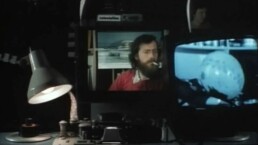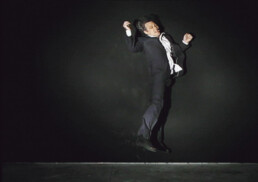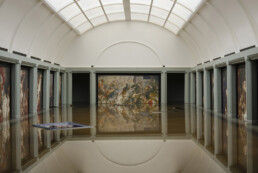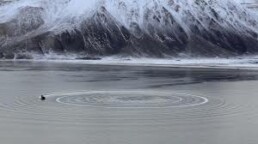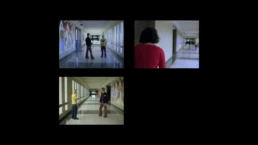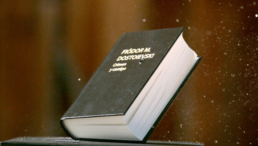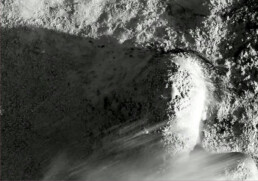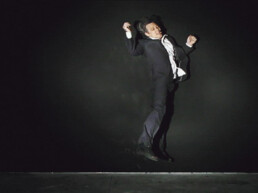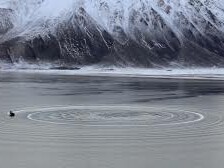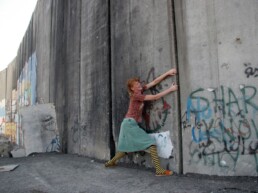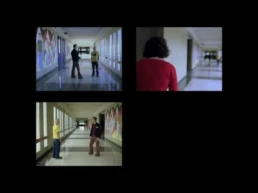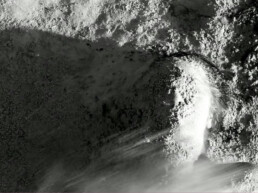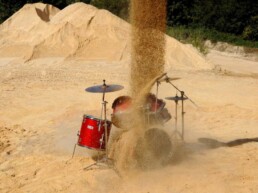VEM 2025 – Julho
16 de Julho
ÉSTA ES UNA PLAZA! – MADRID17 de Julho
MUSEO VOSTELL – MALPARTIDA DE CÁCERES18 de Julho
CINE-TEATRO CURVO SEMEDO – MONTEMOR-O-NOVO19 de Julho
CASA DA CERCA – Centro de Arte Contemporânea – ALMADA20 de Julho
DUPLACENA 77 – LISBOA31 de Julho
CITEMOR
Programa
. Zbigniew Rybczyński: Media (PL, 1980, 2:36)
. Francisco Pradilla Barrero: Breaking News (ES, 2022, 3:02)
. Gary Hill: Wall Piece (US, 2000, 5:00)
. Tezi Gabunia: — Breaking News: The Flooding of the Louvre (GA, 2018-20, 3:02)
. Lukas Marxt: Reign of Silence (AT, 2013, 7:21)
. Rona Yefman: Pippi Longstocking, The Strongest Girl in the World (IL, 2006-08, 3:50)
. Arthur Tuoto: 4x Elephant (BR, 2013, 3:00)
. Jorge García: Del gran otro al objeto a (ES, 2020, 7:46)
. Vanane Borian: Armenian Genocide 1915 (AM, 2014, 2:33)
. Paul Destieu: Fade-Out (FR, 2011, 12:30)
Media (Polónia, 1980, 2:36) – Zbigniew Rybczyński
O filme mistura três realidades, a do ecrã da televisão, a da mesa de edição e a da sala onde se encontram. “O título sugere”, escreveu Marcin Giżycki, ‘que o autor tinha em mente algo mais do que um jogo de ilusão: mostrar que a realidade dos meios de comunicação social é apenas aparentemente um reflexo da realidade, na verdade eles estão sempre a realizar algum tipo de manipulação da nossa consciência’.
Breaking News (Espanha, 2022, 3:02) – Francisco Pradilla Barrero
A identificação do telespectador com o apresentador baseia-se no facto de ser simulado que ambos, ao mesmo tempo, recebem as imagens da mesma realidade e têm as mesmas preocupações que a actualidade provoca. O olhar directo do apresentador é a prova da ancoragem do discurso na realidade, garante a “realidade” das imagens. O apresentador tem dois poderes fundamentais: interpela visualmente o telespectador e habita o espaço televisivo da informação, a partir do qual dá a palavra aos informadores e introduz as notícias que conheceu antes do telespectador. Parece garantir a estabilidade neste mundo de notícias em mudança: está lá para garantir que nos dirá o que está a acontecer de forma credível, aconteça o que acontecer, e a sua figura e credibilidade são especialmente relevantes nestes tempos de desinformação e de fake news.
Wall Piece ((EUA, 2000, 5:00) – Gary Hill
Em Wall Piece, a imagem de um homem que se atira repetidamente contra uma parede e diz uma única palavra em cada impacto é projectada na parede de um espaço completamente escuro. Durante a filmagem, um único flash de luz estroboscópica de extrema intensidade “capturou” o corpo no momento do impacto. Estes momentos singulares foram editados em conjunto para formar um texto linear e uma sequência de um corpo em várias posições contra uma parede. Na instalação, o mesmo tipo de luz estroboscópica utilizado para a gravação é montado no chão e focado na projecção. Pisca a cerca de 60 ciclos por minuto, entrando e sincronizando-se com os flashes de luz gravados. Ocasionalmente, a luz prefigura a imagem, repete a imagem ou, em uníssono, apaga a imagem.
Breaking News: The Flooding of the Louvre (Geórgia, 2018-20, 3:02) – Tezi Gabunia
A água inunda virtualmente o museu icónico, criando uma visão inquietante que antecipa um futuro marcado pelas alterações climáticas. A obra confronta o espectador com a fragilidade dos valores históricos e culturais face às catástrofes naturais.
Reign of Silence (Áustria, 2013, 7:21) – Lukas Marxt
Um altifalante no deserto é o ponto de partida para um longo «zoom out» que expande aquele espaço inóspito perante o nosso olhar.
A história do «Hino à Alegria» no século XX é, ao mesmo tempo, a história do controlo massivo dos povos e do poder da arte ideológica, tornando-se um dos mais simbólicos instrumentos de propaganda e publicidade do processo de colonização dentro das formas de globalização.
Pippi Longstocking, The Strongest Girl in the World (Israel, 2006-08, 3:50) – Rona Yefman
Centrais eléctricas monolíticas; colunas ondulantes de fumo; um sol vermelho de fundo. Sirens é um pequeno documentário experimental que capta as centrais eléctricas Alemãs alimentadas a carvão nos seus últimos anos de produção de energia. Filmado inteiramente a partir de helicópteros, o filme leva-nos numa viagem por terrenos baldios industriais, relembrando assim a passagem do barco de Ulisses pelo estreito das Sereias. Uma odisseia pelo mundo industrial distópico que deixou uma marca permanente na ecosfera terrestre.
4x Elephant (Brasil, 2013, 3:00) – Arthur Tuoto
Colocando lado a lado quatro sequências do filme Elephant (2003) de Gus Van Sant, a obra explora as acções simultâneas do filme, revelando nuances elípticas no seu dispositivo fílmico.
Del gran otro al objeto a (Espanha, 2020, 7:46) – Jorge García
“Do grande Outro ao objeto a”, o título do seu projecto, alude ao pensador Jacques Lacan, continuador dos ensinamentos psicanalíticos de Sigmund Freud: São conceitos de Lacan e, embora não seja especialista, interessa-me mais o que diz respeito ao complexo de Édipo do que Freud, porque neste caso parece-me sexista e até misógino, é a minha opinião, e no entanto Lacan o que faz é expandir e redefinir a psicanálise, estando mais de acordo com os tempos. O título é um aceno a isso”, explica García, sublinhando as dificuldades inerentes ao próprio facto de organizar, numa carreira de tiro, a sessão através da qual os livros foram perfurados em tiros sucessivos.
Armenian Genocide 1915 (Arménia, 2014, 2:33) – Vanane Borian
Este vídeo é dedicado ao Genocídio Arménio. Fala sobre as mulheres no Genocídio, na guerra. Sobre a violência sexual na guerra. O vídeo fala da sociedade que nega estes factos. O enterro do corpo de uma mulher é o símbolo da anulação da história.
Fade-Out (França, 2011, 12:30) – Paul Destieu
“Fade-out” é um termo técnico utilizado tanto no cinema como no som para designar uma transição ou um fim: a diminuição de um sinal até ao silêncio ou ao desaparecimento completo. A cena centra-se no enterramento progressivo de uma bateria sob um fluxo de gravilha, em que cada impacto é amplificado e registado como um choque nas diferentes partes do instrumento. A sequência propõe a experiência imersiva de um processo técnico bruto, materializando a transição entre dois estados. O fluxo produz uma secção rítmica que se transforma lentamente num choque sonoro e visual.
VEM 2025 – July
16 July
ÉSTA ES UNA PLAZA! – MADRID17 July
MUSEO VOSTELL – MALPARTIDA DE CÁCERES18 July
CINE-TEATRO CURVO SEMEDO – MONTEMOR-O-NOVO19 July
CASA DA CERCA – Centro de Arte Contemporânea – ALMADA20 July
DUPLACENA 77 – LISBOA31 July
CITEMOR
Programme
. Zbigniew Rybczyński: Media (PL, 1980, 2:36)
. Francisco Pradilla Barrero: Breaking News (ES, 2022, 3:02)
. Gary Hill: Wall Piece (USA, 2000, 5:00)
. Tezi Gabunia: — Breaking News: The Flooding of the Louvre (GA, 2018-20, 3:02)
. Lukas Marxt: Reign of Silence (AT, 2013, 7:21)
. Rona Yefman: Pippi Longstocking, The Strongest Girl in the World (IL, 2006-08, 3:50)
. Arthur Tuoto: 4x Elephant (BR, 2013, 3:00)
. Jorge García: Del gran otro al objeto a (ES, 2020, 7:46)
. Vanane Borian: Armenian Genocide 1915 (AM, 2014, 2:33)
. Paul Destieu: Fade-Out (FR, 2011, 12:30)
Media (PL, 1980, 2:36) – Zbigniew Rybczyński
The film mixes three realities, that of the television screen, the editing table and the room where they meet. ‘The title suggests,’ wrote Marcin Giżycki, «that the author had in mind something more than a game of illusion: to show that the reality of the media is only apparently a reflection of reality, in fact they are always carrying out some kind of manipulation of our consciousness.
Breaking News (ES, 2022, 3:02) – Francisco Pradilla Barrero
The identification of the viewer with the host or presenter is based on the fact that it is simulated that both, at the same time, receive the images of the same reality and have the same concerns that current affairs provoke. The direct gaze of the presenter is proof of the anchoring of the discourse in reality, it guarantees the ‘reality’ of the images. The presenter has two fundamental powers: he interpellates the viewer visually and inhabits the television space of information, from which he gives the floor to informants and introduces news that he has known before the viewer. He seems to guarantee stability in this changing world of news: he is there to guarantee that he will tell us what is happening in a credible way, no matter what happens, and his figure and credibility is especially relevant in these times of disinformation and fake news.
Wall Piece (USA, 2000, 5:00) – Gary Hill
In Wall Piece, the image of a man repeatedly throwing himself against a wall and speaking a single word with each impact is projected onto the wall of a completely darkened space. During the filming, a single flash of strobe light of extreme intensity ‘captured’ the body at the moment of impact. These singular moments were edited together to form a linear text and sequence of a body in various positions against a wall. In the installation, the same type of strobe light used for the recording is mounted on the floor and focused on the projection. It flashes at approximately 60 cycles per minute, entering and synchronising with the recorded flashes of light. Occasionally, the light foreshadows the image, repeats the image or, in unison, erases the image.
Breaking News: The Flooding of the Louvre (GE, 2018-20, 3:02) – Tezi Gabunia
Water virtually floods the iconic museum, creating an unsettling vision that anticipates a future marked by climate change. The work confronts the viewer with the fragility of historical and cultural values in the face of natural disasters.
Reign of Silence (AT, 2013, 7:21) – Lukas Marxt
Begins with a still shot of a lake in front of mountains. A boat enters, traces a spiral in the water following instructions and leaves the scene, leaving only its wake. Marxt explores the relationship between human and environment in this isolated, almost surreal landscape, evoking Land Art and Robert Smithson’s Spiral Jetty.
The film not only documents, but also superimposes an artistic layer on nature, inviting us to reflect on time and perception. In the end, the image returns to its initial state, highlighting the temporality of human intervention in the environment.
Pippi Longstocking, The Strongest Girl in the World (IL, 2006-08, 3:50) – Rona Yefman
The character of Pippi Longstocking was originally created by the Swedish writer Astrid Lindgren and represents her socially subversive ideas that correlate with and inspire my own notion of radicalism. In the literary version of Pippi Longstocking, she is portrayed as rebellious, funny and independent, with the ability to reverse social circumstances and challenge the conventions of normal behaviour. By extracting Pippi from her original source and projecting her character into the contemporary, Danish sound and performance artist Tanja Schlander enables malleability by confronting, challenging and transforming structures of power and authority to offer a new mode of liberation.
4x Elephant (BR, 2013, 3:00) – Arthur Tuoto
Placing side by side four sequences from Gus Van Sant’s film Elephant (2003), the work explores the film’s simultaneous actions, revealing elliptical nuances in its filmic device.
Del gran otro al objeto a (ES, 2020, 7:46) – Jorge García
«From the big Other to the object a’, the title of your project, alludes to the thinker Jacques Lacan, the continuator of Sigmund Freud’s psychoanalytic teachings. They are Lacan’s concepts and, although I am not an expert, I am more interested than Freud in what concerns the oedipal complex, because in this case it seems to me macho and even misogynist, that is my opinion, and yet Lacan what he does is to expand and redefine psychoanalysis, being more in keeping with the times. The title is a nod to that», García explains, while underlining the difficulties inherent in the very fact of organising, in a shooting range, the session by means of which the books were perforated in successive shots.
Armenian Genocide 1915 (AM, 2014, 2:33) – Vanane Borian
This video is dedicated to the Armenian Genocide. It talks about women in the Genocide, in the war. About sexual violence in the war. It tells us about the society that denies these facts. The burial of a woman’s body is the symbol of the annulment of history.
Fade-Out (FR, 2011, 12:30) – Paul Destieu
«Fade-out is a technical term used in both film and sound to designate a transition or an end: the diminishing of a signal until silence or complete disappearance. The scene focuses on the progressive burial of a drum kit under a flow of gravel where each impact is amplified and recorded as a shock on the different parts of the instrument. The sequence proposes the immersive experience of a raw technical process by materialising the transition between two states. The flow produces a rhythmic section that slowly turns into a sonic and visual shock.
